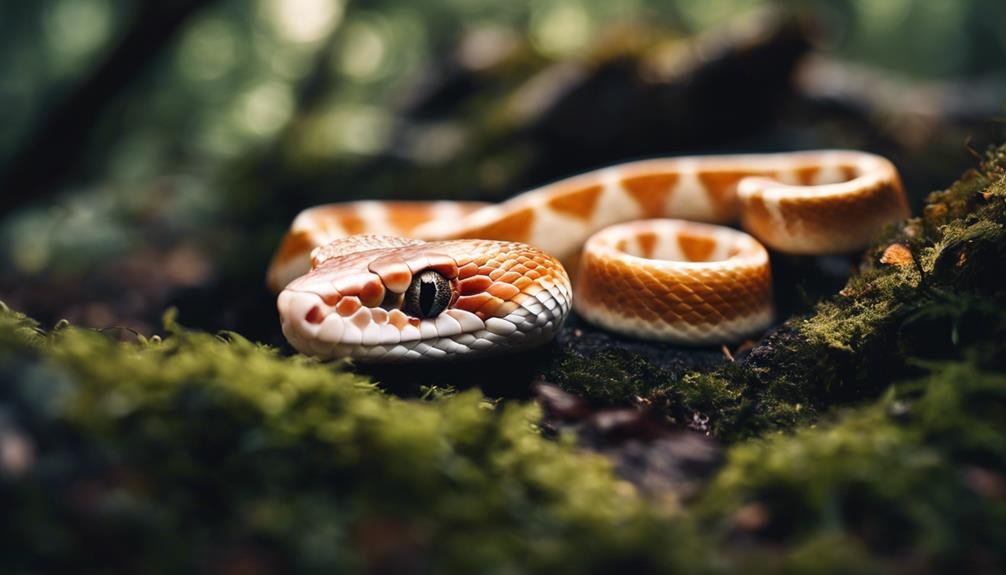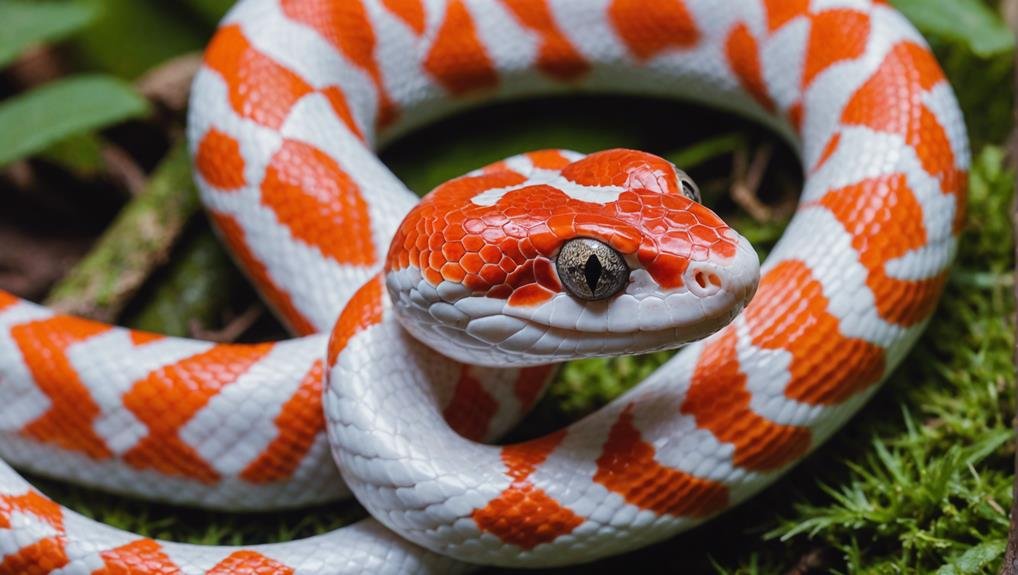If you’re considering an Albino Corn Snake as a pet, they offer a blend of striking appearance and manageable care requirements. These snakes are ideal for novice and seasoned reptile enthusiasts with their vivid, melanin-free colors and gentle demeanor. You must provide them with a suitable habitat, appropriate diet, and regular health care. But what truly sets Albino Corn Snakes apart? There’s more to their alluring nature and care that might surprise you.
Key Takeaways
- Due to the absence of melanin, albino corn snakes feature vibrant colors like red, orange, yellow, and white.
- They require enclosures with controlled heating (85-90°F) and humidity (65-75%).
- Their diet mainly consists of pre-killed or frozen rodents, varying feeding frequency by age.
- Common health issues include respiratory illnesses, ticks, mites, dermatitis, and stomatitis.
- Albino corn snakes are docile, non-venomous, and ideal for beginner owners.
Physical Characteristics
Albino corn snakes, lacking dark pigments, display vibrant colors like red, orange, yellow, and white. Their unique appearance is due to the absence of melanin, which results in these stunning hues. As you observe an albino corn snake, you’ll notice they have a slender body that can grow to 2-6 feet long, making them elegant and fascinating creatures to watch.
One of the main reasons these snakes are popular pets is their striking physical characteristics. The pale, almost translucent skin contrasted with bold, vivid colors makes them stand out among other snake species. Their lack of dark pigments doesn’t just affect their color; it also contributes to their distinct, almost ethereal look.
When you hold an albino corn snake, you can appreciate their smooth scales and graceful movements. Weighing around 1-2 pounds, they’re easy to handle, and their manageable size makes them suitable for novice and experienced snake enthusiasts. Their appearance and demeanor contribute to their popularity in the pet trade.
In addition to their beauty, these snakes can live for 15-20 years in captivity, offering long-term companionship for those who choose to keep one in their homes.
Habitat and Enclosure
Creating a suitable habitat and enclosure for your corn snake is essential for its health and well-being. An Albino Corn Snake requires a spacious enclosure with controlled heating and humidity. For heating, provide a basking spot that maintains temperatures between 85-90°F. This is important for their digestion and overall activity levels. Humidity should be between 65-75% to support shedding and respiratory health.
A large water dish must be in your Albino Corn Snake’s habitat. Not only does it provide drinking water, but it also offers a place for your snake to soak, which aids in shedding. An appropriate substrate is crucial; it should retain moisture well but not become overly damp. Coconut fiber or aspen shavings are excellent choices.
Incorporate multiple hiding spots within the enclosure. These can be made from commercially available hides or simple items like half logs or caves. Hiding spots help your snake feel secure and reduce stress. Additionally, adding climbing branches can simulate their natural environment and provide mental stimulation.
Regular spot cleaning and periodic deep cleaning of the enclosure are necessary to maintain a healthy living space for your Albino Corn Snake.
Diet and Feeding
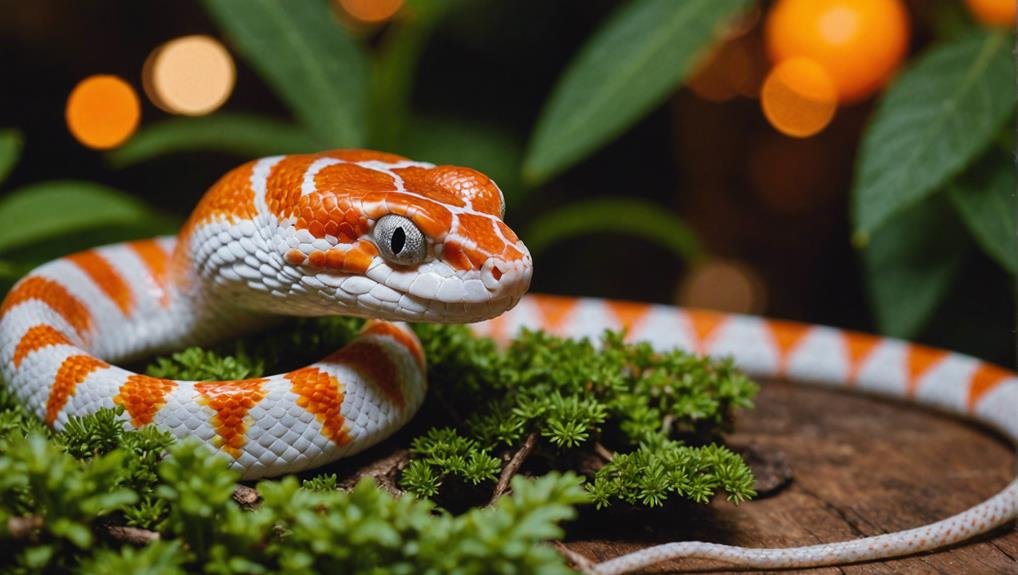

When feeding your Albino Corn Snake, you’ll primarily offer rodents like rats and mice. It’s best to use pre-killed or frozen mice to guarantee their safety during feeding. Feeding live rodents isn’t recommended due to the risk of injury to your snake. Before offering frozen rodents, always thaw them to room temperature. This prevents digestive issues and ensures easier consumption.
Your Albino Corn Snake’s feeding schedule will depend on their age. Baby snakes need to eat more frequently than adults. Typically, baby snakes require feeding every 5-7 days, while adults can go 7-10 days between meals. Always monitor your snake’s health and adjust the feeding schedule as needed.
Here’s a quick reference table to help you manage your Albino Corn Snake’s diet:
| Age Group | Feeding Frequency |
|---|---|
| Baby Snakes | Every 5-7 days |
| Juvenile Snakes | Every seven days |
| Adult Snakes | Every 7-10 days |
| Pre-killed Mice | Recommended |
| Frozen Mice | Thaw to room temperature |
Health Issues
Regularly monitoring your corn snake’s health is essential to catch any potential issues early. Albino corn snakes are prone to several health problems, including respiratory illnesses, ticks & mites, dermatitis, and stomatitis. Watch for symptoms like eating refusal, breathing trouble, skin irritation, or ticks and mites. These signs can indicate underlying health issues that require immediate attention.
Respiratory illnesses often manifest through labored breathing or wheezing, while dermatitis may appear as red, inflamed skin. Stomatitis, or mouth rot, can cause swelling and discharge around the mouth, making it difficult for your snake to eat. If you notice your snake refusing to eat or struggling with discomfort, it’s essential to schedule a vet visit promptly.
Ticks & mites can also be a significant problem, leading to skin irritation and potential infections. Regularly check your snake’s skin and enclosure for these parasites.
Consistent health checks, including weight loss and regurgitation monitoring, are crucial for maintaining your albino corn snake’s well-being. Proper care and attentive tracking will help you efficiently prevent and address these health issues.
Behavior and Temperament
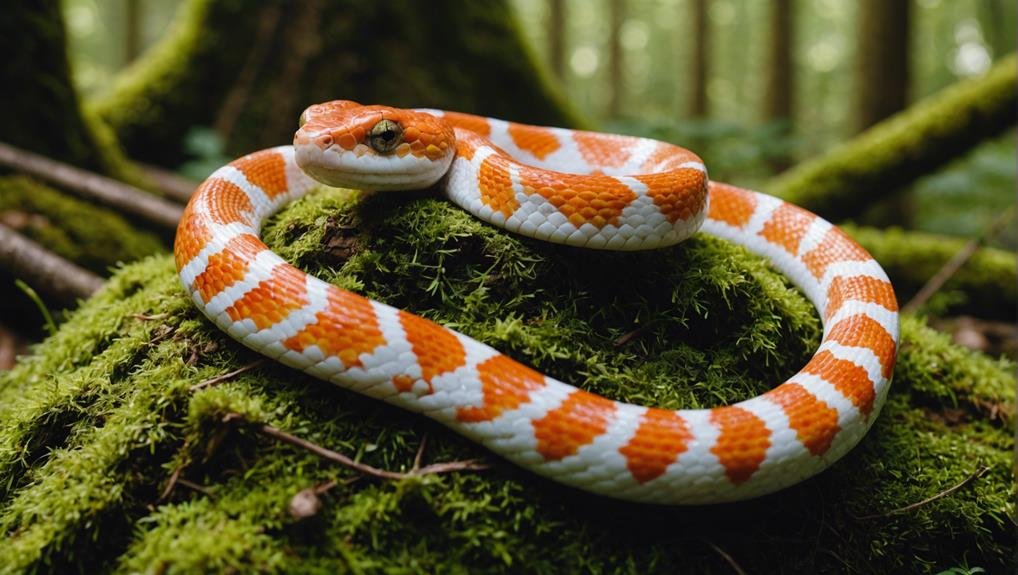

Albino corn snakes are known for their docile nature, making them ideal pets for beginners. Their calm and approachable demeanor means they rarely exhibit aggressive behavior, allowing even novice snake owners to feel comfortable around them. As diurnal creatures, they’re most active during the day, which aligns well with human schedules, making interactions easier and more frequent.
These snakes are non-venomous constrictors, relying on constriction rather than venom to subdue prey. This makes them safer to handle compared to venomous species. Albino corn snakes are naturally solitary, preferring to live alone except during mating season. This solitary lifestyle means you won’t need to worry about them needing companionship.
Despite their solitary tendencies, albino corn snakes are known for their interactive and engaging behavior. They’re curious and often explore their environment, providing endless fascination for their owners. This combination of a docile temperament and engaging behavior makes them popular pets.
Their curious nature allows for enjoyable and interactive experiences, making them a perfect choice for beginner snake owners looking for a pet that’s both easy to care for and engaging.
Handling Tips
To guarantee a positive experience for both you and your albino corn snake, begin handling sessions gradually and with care. Start with short handling sessions to allow your snake to get used to you and its new environment. This approach helps prevent stress and fosters trust between you and your pet.
When handling albino corn snakes, always support the snake’s body. Use both hands to evenly distribute the snake’s weight without squeezing or applying excessive pressure. This helps secure the snake’s comfort and safety. Avoid sudden movements or loud noises, as these can startle and stress the snake, making it less willing to be handled.
Limit handling sessions to once a day or less to prevent unnecessary stress. It’s crucial to give your snake time to adjust to its environment and your presence. As your snake becomes more comfortable, you can gradually increase the handling time. This gradual increase will help your albino corn snake feel secure and relaxed.
| Handling Tips | Details |
|---|---|
| Start with short sessions | Prevents stress and builds trust |
| Support the snake’s body | Use both hands to distribute weight evenly |
| Avoid sudden movements | Keeps the snake calm and relaxed |
| Limit handling sessions | Once a day or less to prevent unnecessary stress |
Lifespan and Size
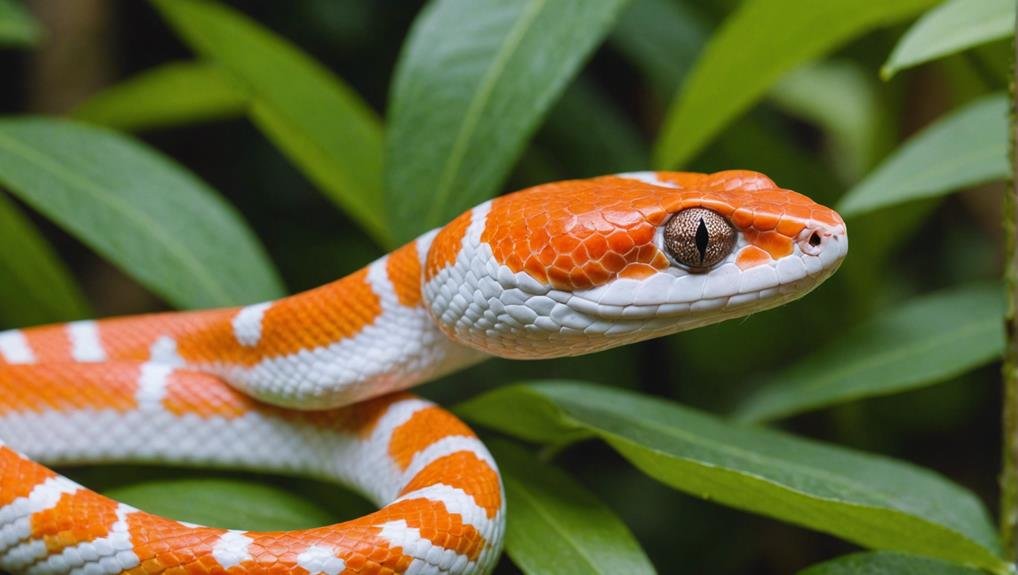

Understanding the lifespan and size of your albino corn snake is essential for providing the best care and environment. Albino corn snakes typically have a lifespan of 15-20 years in captivity, though some can live even longer with proper care. This longevity means you’ll need to be prepared for a long-term commitment.
In terms of size, albino corn snakes can grow to lengths of 3-6 feet. Baby albino corn snakes usually start at around 15 inches and gradually increase in size as they mature. Their growth depends on various factors, including genetics and the care they receive. As your snake grows, you must upgrade its habitat to spacious enclosures that accommodate its increasing size and activity levels.
One of the most fascinating aspects of albino corn snakes is their unique color patterns. Due to the lack of melanin pigment, these snakes exhibit striking shades of red, orange, yellow, and white. These vibrant colors make them visually appealing and distinguish them from other corn snake varieties.
Conclusion
To sum up, owning an Albino Corn Snake can be a rewarding experience. You’ll be captivated by their vibrant colors and engaging behavior.
Your snake will thrive with the right habitat, a proper diet, and regular health check-ups. Their docile nature makes them perfect for beginners, and you’ll enjoy the interactive companionship they offer.
If you’re looking for a visually striking and fascinating pet, an Albino Corn Snake is an excellent choice.
Related Article:
https://thereptileguide.com/why-do-bearded-dragons-bob-their-heads/
https://thereptileguide.com/what-do-iguanas-eat/

